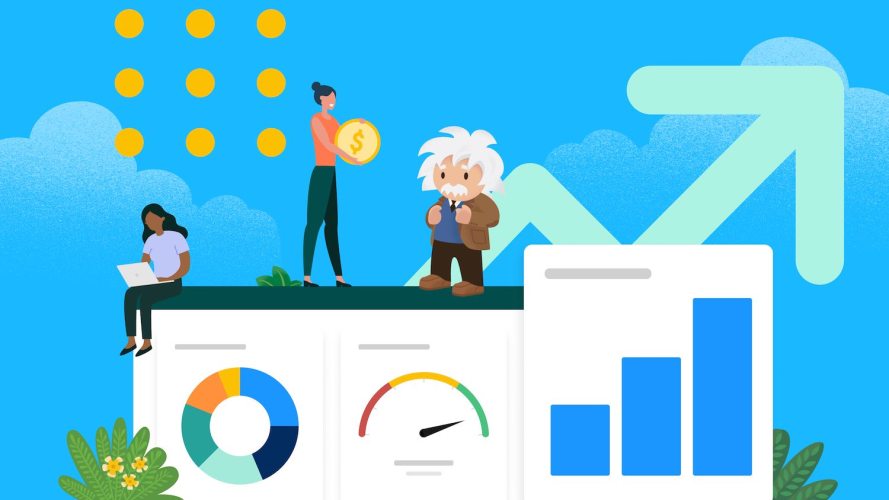3 Ways Generative AI Will Help Marketers Connect With Customers
3 min read


Sales teams have come a long way since the days of Post-it notes and file cabinets. First came computers, but customer data was still hard to find and tucked away in a hundred different systems.
Then came sales automation. Now you could sync data across tools, reduce manual hand-offs, give every team access to the same data, and layer analytics on top. Good stuff. But the best part? Sales automation was just getting started.
Today, with the help of AI, it’s making yet another leap in what it can do. Below are key automation milestones: where we started, where we are now, and where we’re headed.
Sales Cloud Unlimited Edition boosts sales productivity with the combined power of automation, data, and AI, speeding up sellers by helping you do market research, write great emails, and get insights that help you close every deal.



Sales automation is the process of using technology to perform often tedious human tasks, reducing manual time, effort, and error.
Traditional sales automation has two primary applications. The first involves capturing and updating customer data, like pulling deal information from emails and adding to account records. The second is workflow automation, where actions in the sales process trigger once-manual tasks, like sending quotes for approval.
More advanced applications of sales automation focus on data analysis. Pipeline management is a great example: automated analysis paired with AI can find red flags in opportunities in a pipeline based on deviations from expected KPIs, and deliver recommended actions that help reps and leaders keep sales on track.
Even more impressive is the pairing of automation and generative AI. Based on either automated data analysis or prompts, generative AI can create new content, like emails, call summaries, and sales reports. Your CRM or system of record can then automatically send these to internal stakeholders or customers.
As it now stands, reps spend only 28% of their week actually selling. The rest is made up of critical but tedious tasks, like prioritizing leads, researching prospects, and entering sales information. The more we can lean on sales automation to perform these tasks (while capturing critical customer data), the more time sellers have to focus on actually selling.
The rest of the sales team also stands to benefit as well. When you combine AI and automation to help with pipeline and sales call analysis, managers get insights that help them with personalized coaching. Sales leaders get deal signals that help them create more accurate forecasts. And sales operations gets a foundation of connected, up-to-date data to make the sales process more efficient.
The story of sales automation is really the story of data. At its most basic level, sales automation updates data based on activity triggers (like when calls are made, emails are received, or deals are moved to the next stage in the sales process). With the help of predictive AI, sales automation goes a step further, analyzing pipeline data and delivering predictions about the best actions to take to move deals forward. Add in generative AI and you have the ability to automatically generate material (like emails) based on existing data that can help you speed up the sales process.
Here’s a closer look at how all of this works:
Customer relationship management (CRM) software is square one for sales automation because it houses, organizes, and prioritizes your customer data. Every customer interaction leaves a trail of data in its wake: emails you’ve sent, conversations and meetings you’ve had, quotes and contracts that are waiting to be signed. Instead of logging this data by hand, sales automation can pull relevant information — like suggested meeting times, pricing details, and new contact information — and update deal records automatically. That way, every time you pull up a customer record, you know the information you’re seeing is current.
What if your data is housed in different software? Sales automation can sync data across tools instantly so that reps don’t have to manually update everything in the tech stack. Even better, you know that if a customer engages with you on one platform, their information will be updated in all the others — no missed connections.
About a decade ago, with the arrival of AI, sales automation expanded its reach. All of a sudden, it wasn’t just automating the organization and syncing of data. It was also automating analysis and, with the help of predictive AI, surfacing trends, anomalies, and outliers guided by a set of target metrics.
Today, AI-powered CRMs can automatically analyze pipelines and predict when a deal is at risk of stalling to help sales leaders intervene and get the forecast back on track. How does it know what to look for? Sales teams — typically managers and ops — set parameters and target metrics in the CRM that trigger alerts. For example, they might set a trigger for any deal that spends more than 10 days in a single stage of the sales process.
AI can also take in conversational data from sales calls to automatically surface relevant keywords, trends, and coachable moments. Parameters set in the CRM tell it what to look for, from objections to pricing concerns to competitor mentions.
In recent years, sales automation made another expansive leap with generative AI. This new intelligence goes beyond recommending an action. It takes action for you. Based on activity triggers or prompts, it writes emails, conducts research, and creates sales reports — including forecasts — using historic customer data. It even writes sales pitches. This step forward is such an efficiency booster, a recent study showed that sales professionals believe generative AI can save them an average 4.5 hours a week.
Now that we’ve looked at how sales automation works, let’s look at examples of how you can use it in your daily job.
Sales automation touches every part of the sales process, from lead to close. Below, we share the most important examples of how you can use it, from prioritizing leads to writing emails and creating more accurate forecasts.
Contact management. Get contacts out of spreadsheets and into a CRM, and let sales automation keep them updated with every customer interaction. Get a phone call or an email? Sales automation can grab the phone number or email address and add it to your contact record. Even better, it can show you key information every time you pull up a prospect: activity history, customer communications, internal account discussions, and even insights from social media.
Prospecting. Using preset criteria, sales automation can evaluate new marketing leads to see if they’re worth a call, then funnel those that pass muster to sellers. Sales Engagement does this automatically so you know which deals are most likely to close. You can also prepare emails to send automatically to leads after first contact to help push them down the funnel.
Opportunity management. Automated workflows can guide reps to next steps in the sales process for each opportunity, ensuring nothing lags in the pipeline. You can also set up automatic triggers at each stage, requiring reps to complete specific tasks before moving the deal forward. For example, before completing the discovery stage, a CRM may require a rep to confirm they have made contact with an economic decision-maker before entering into negotiation.
Conversation analysis. Sales managers often spend hours every week listening to sales calls, searching for trends in what customers are saying and listening for coaching opportunities based on what sales reps could do better. Sales automation in call coaching software can turn these phone calls into searchable transcripts, then surface trends and coachable moments for you based on keyword analysis.
Territory management. Sales managers are tasked with taking categories like customer segment and seller specialty, and laying all their accounts onto a map in a way that maximizes customer coverage and increases revenue. It has to be fair for sellers, too. Sales automation can take on this analysis and planning, helping you create multiple territory models, preview them before rollout, and keep optimizing and balancing them throughout the year.
Sales forecasting. Sales leaders are under pressure to predict future revenue as accurately as possible. Sales automation, paired with AI, can help by monitoring pipeline health in real time, highlighting deals that are at risk of being missed and providing recommendations for how to intervene to get those deals (and the forecast) back on track.
Quote configuration. You’ve spent all that time nurturing a prospect to close, only to have them wait for days or even weeks while you scramble to put a quote together. Sales automation can speed up that process so it happens in minutes. It tracks which products are part of your deal, creates a new quote with relevant customer data, and emails it to customers directly from your CRM in a few clicks.

3 min read

6 min read
If you’re ready to go all in on sales automation, look for CRM software that unites customer data on one platform, updates that data in real time, uses analytics and AI, and brings in a layer of trust to keep your data private and secure. Here’s what to look for:
A platform. Many sellers say that even when tools work great on their own, the pain begins when you put them together. Customer data ends up locked up in different systems, requiring human time to reconcile it. Remedy this pain by unifying your customer data on one platform, giving every team a single customer view.
Real-time data. Whatever CRM you land on, make sure it has real-time capabilities, so data is processed and available for use right after it’s captured. This allows for the continual updating of customer data after every interaction, like sales calls, website visits, and conference scans. Data Cloud is a great example of this in action.
Predictive AI. With the foundation of real-time data on a platform, layer predictive AI on top. As you sell, analytics tools can continuously monitor prospects and customers in your pipeline to send you insights and alerts. For example, if an existing SaaS customer is at risk of churning based on low engagement signals, it could send you an alert and recommend discounts or other incentives to maintain their contract.
Generative AI. What could be more sales automation-ey than asking a computer to do work for you? Look for generative AI that can leverage your actual customer data, rather than just publicly available data, to create hyper-relevant sales materials.
A trust layer. As we allow AI models to look at customer data, we have to make sure that data is protected. A trust layer has the ability to send customer data to generative AI models while keeping it secure and private. Here’s how we do it at Salesforce.
While sales automation replaces human work, it doesn’t replace humans. It makes humans better at their jobs. It’s why the most powerful question a sales operations team can ask is this: “What else can I automate today?”
The answer is always something new. The one thing we do know is the human bond will remain ours alone to build. Why not let sales automation do the rest?
Watch these demos to see how Sales Cloud automation and AI help sellers close more deals today. You’ll learn how to sell faster and smarter on one platform.




Get the latest articles in your inbox.